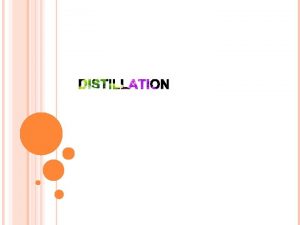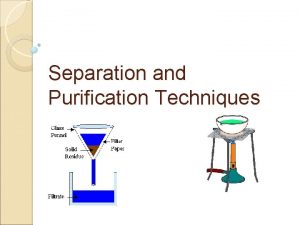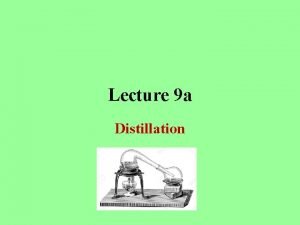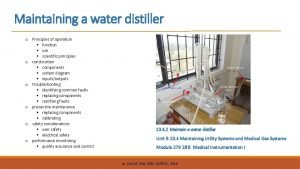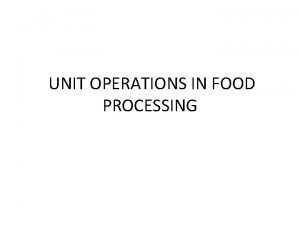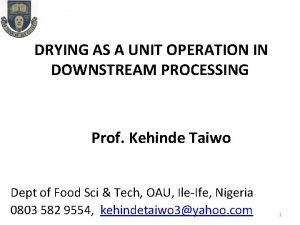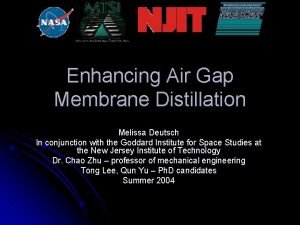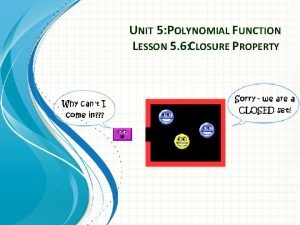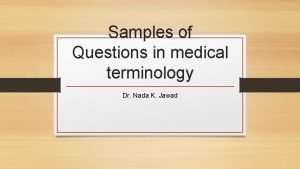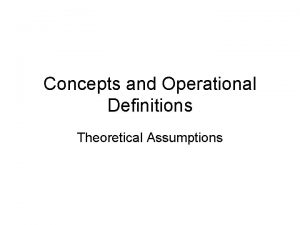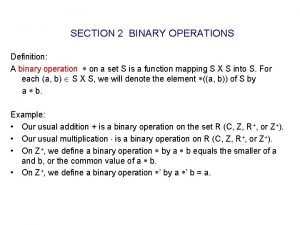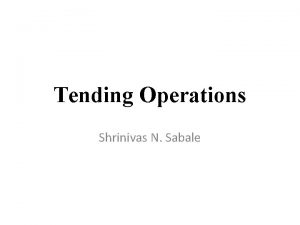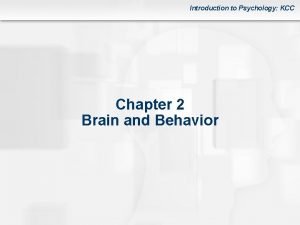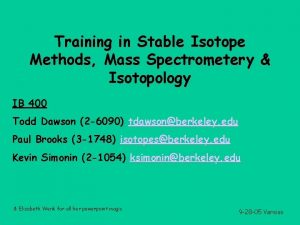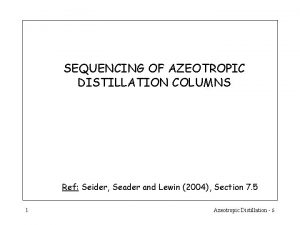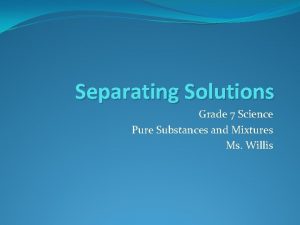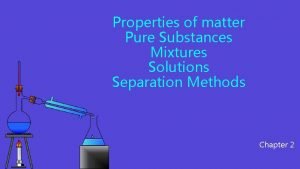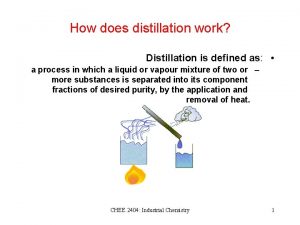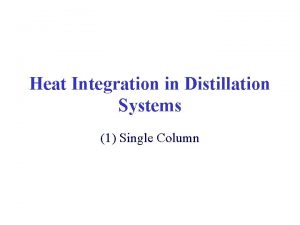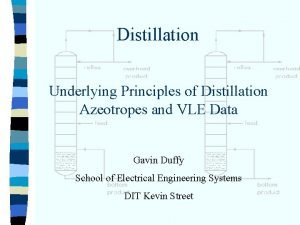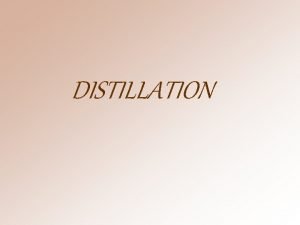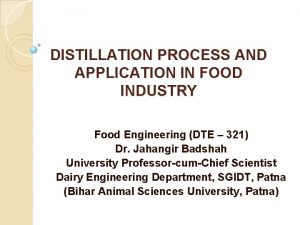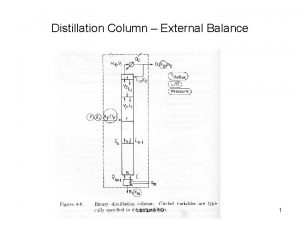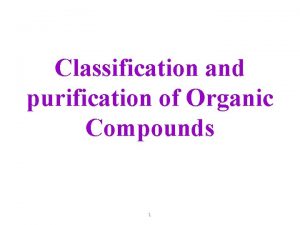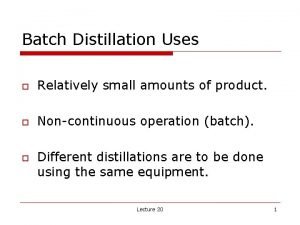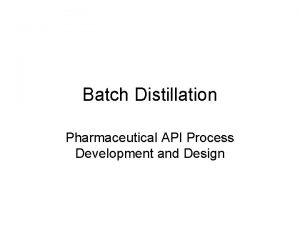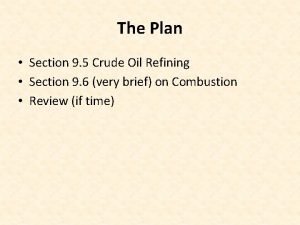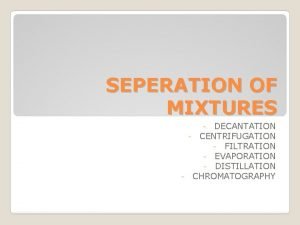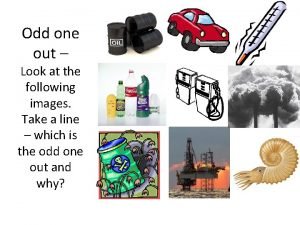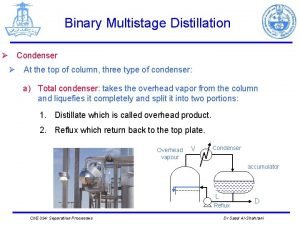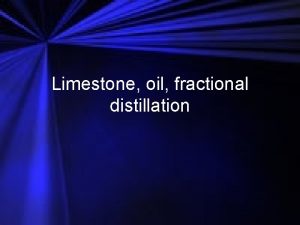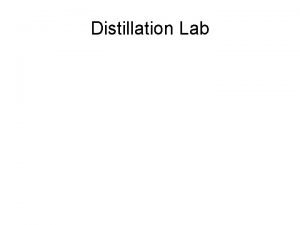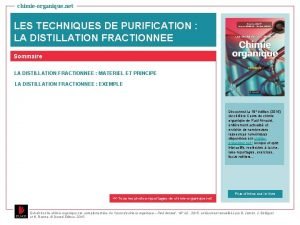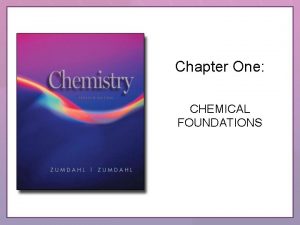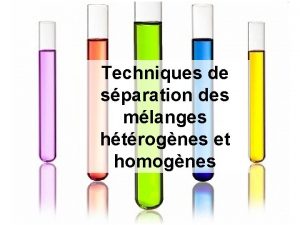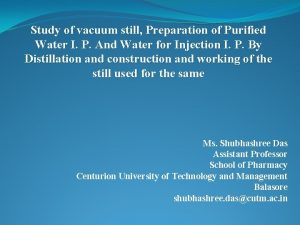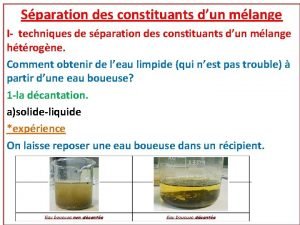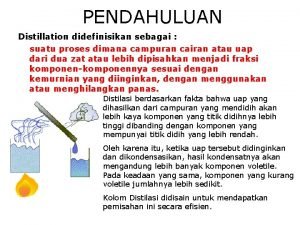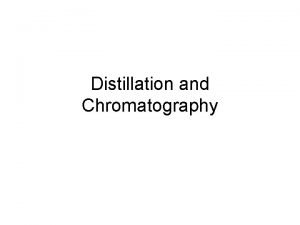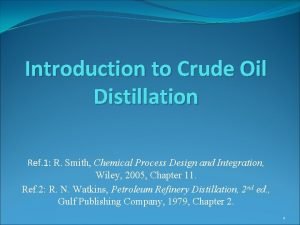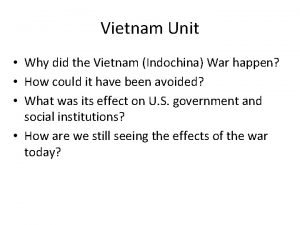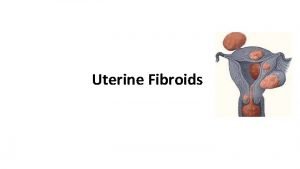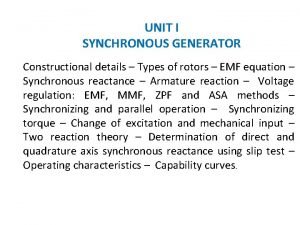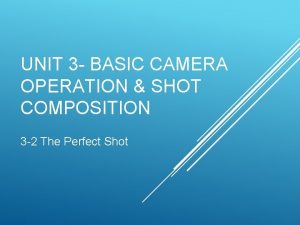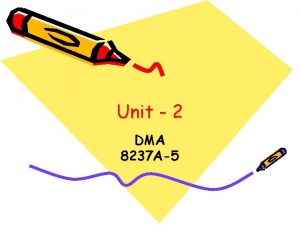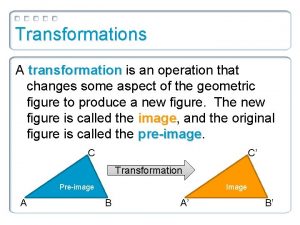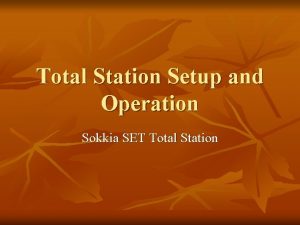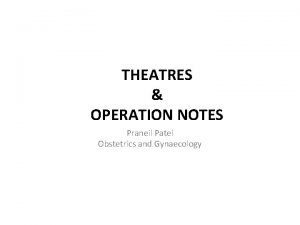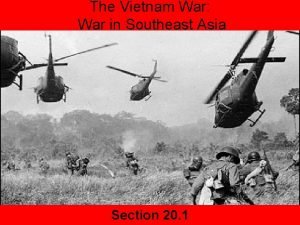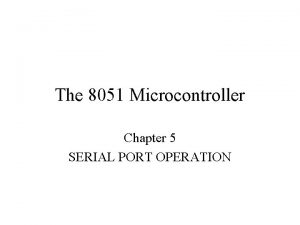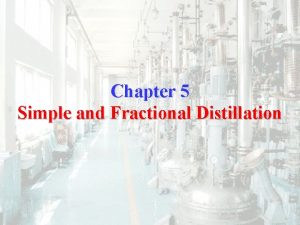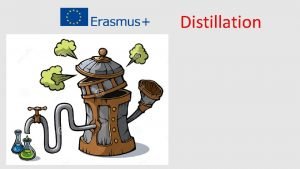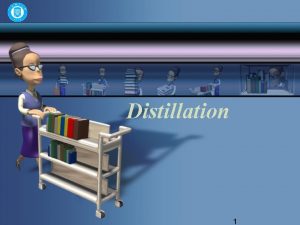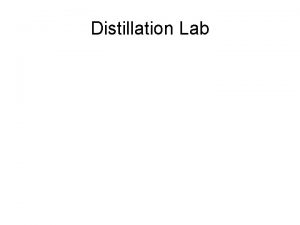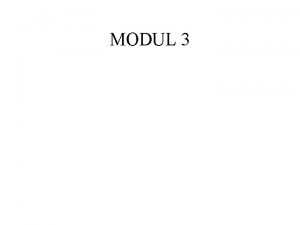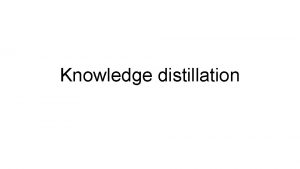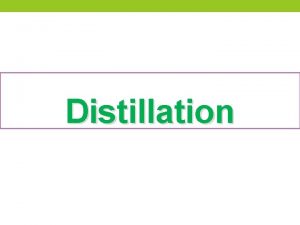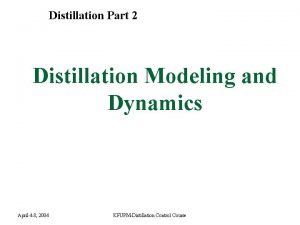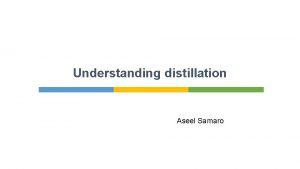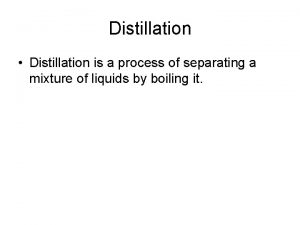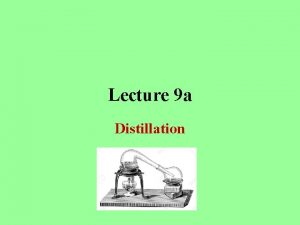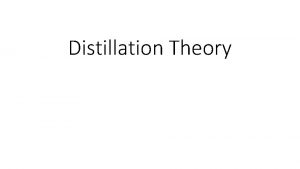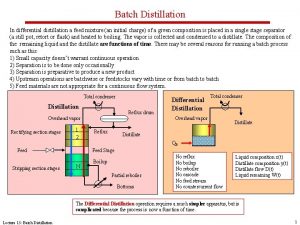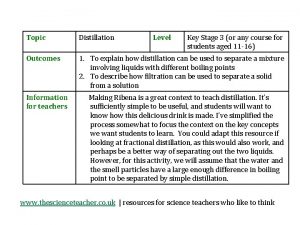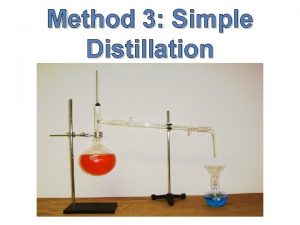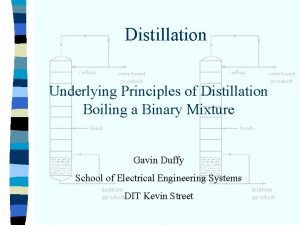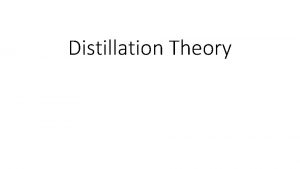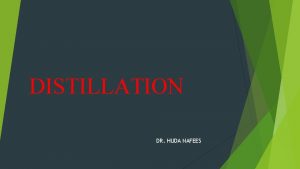DISTILLATION DEFINITION Distillation is an unit operation which




































































![8. FRACTIONAL DISTILLATION Fractionating columns Types A] Packed columns and B] Plate columns 8. FRACTIONAL DISTILLATION Fractionating columns Types A] Packed columns and B] Plate columns](https://slidetodoc.com/presentation_image_h/b5e6c8bd8c74be44c1c3ec870686fbc0/image-69.jpg)
![8. FRACTIONAL DISTILLATION Fractionating columns Types A] Packed columns 8. FRACTIONAL DISTILLATION Fractionating columns Types A] Packed columns](https://slidetodoc.com/presentation_image_h/b5e6c8bd8c74be44c1c3ec870686fbc0/image-70.jpg)
![8. FRACTIONAL DISTILLATION Fractionating columns Types A] Packed columns Some form of packing is 8. FRACTIONAL DISTILLATION Fractionating columns Types A] Packed columns Some form of packing is](https://slidetodoc.com/presentation_image_h/b5e6c8bd8c74be44c1c3ec870686fbc0/image-71.jpg)
![8. FRACTIONAL DISTILLATION Fractionating columns Types B] Plate columns 8. FRACTIONAL DISTILLATION Fractionating columns Types B] Plate columns](https://slidetodoc.com/presentation_image_h/b5e6c8bd8c74be44c1c3ec870686fbc0/image-72.jpg)
![8. FRACTIONAL DISTILLATION Fractionating columns Types B] Plate columns (Bubble cap) 8. FRACTIONAL DISTILLATION Fractionating columns Types B] Plate columns (Bubble cap)](https://slidetodoc.com/presentation_image_h/b5e6c8bd8c74be44c1c3ec870686fbc0/image-73.jpg)
![8. FRACTIONAL DISTILLATION Fractionating columns Types B] Plate columns Many forms of plates are 8. FRACTIONAL DISTILLATION Fractionating columns Types B] Plate columns Many forms of plates are](https://slidetodoc.com/presentation_image_h/b5e6c8bd8c74be44c1c3ec870686fbc0/image-74.jpg)
![8. FRACTIONAL DISTILLATION Fractionating columns Types B] Plate columns (Bubble cap) Advantages: The bubble 8. FRACTIONAL DISTILLATION Fractionating columns Types B] Plate columns (Bubble cap) Advantages: The bubble](https://slidetodoc.com/presentation_image_h/b5e6c8bd8c74be44c1c3ec870686fbc0/image-75.jpg)

- Slides: 76

DISTILLATION

DEFINITION “Distillation is an unit operation which involves separation of a vaporizable component from a multicomponent system and subsequent condensation of vapours. ” “Distillation is a process of separating the component substances from a liquid mixture by selective evaporation and condensation. ”

Distillation is the separation of the constituents of a mixture including a liquid by partial vaporization of the mixture and separate collection of the vapour. “Distillation is defined as the separation of the components of a liquid mixture by a process involving vaporization and subsequent condensation at another place. ”

HISTORY � Practiced as early as 3500 BC for isolation of odoriferous principles from flowers, leaves etc. � In 11 th and 12 th century it was used for isolation of alcohol from wines. � In Ayurveda the process of separation for active constituents of crud drugs also mentioned.

DISTILLATION VS EVAPORATION VS DRYING Evaporation Distillation Vaporization of bulk liquid above boiling point Vaporization of bulk liquid below boiling point Product desired is distillate(solvent used) Product desires is concentrated liquid(concentrate d solute) Process of separation of the components of liquid mixture Process of removal of the liquid solvent Drying Slow evaporation of wet solid bulk (small amount of liquid) Product desires is Solid residue(dried solute) Process of complete removal of the

APPLICATIONS: Separation of volatile oils- cloves(Eugenol comprises 72 -90%, Vanilin, acetyl eugenol). Separation of drugs obtained from plant and animal sources- Vit. A from fish liver oil Purification of organic solvents-absolute alcohol (100%). Purification of drugs obtained from chemical process. Manufacture of official preparations -sprit of nitrous ether, sprit of ammonia, D. water and water for inj. Quality control methods- Alcohol content in elixir(4 -40%). Refining of petroleum products- Petroleum ether 60, 80. Recovery of solvents- synthesis.

APPLICATIONS IN PHARMACY • Distillation is used in Pharmacy either to extract volatile active principles from vegetable drugs or to separate volatile substances from their less volatile impurities. • It also provides a method of recovering volatile solvents, notable alcohol for further use. • It is used to separate or purify thermolabile chemicals. • To purify water and other solvents

LIQUID MIXTURES CAN BE COMPOSED OF Miscible liquids Partial Miscible liquids Immiscible Liquids

TERMINOLOGY Binary Mixture When two liquids mixed together, they may be miscible with each other in all proportion, such miscible liquid are known as binary mixtures of liquid. Example: - Ethanol + Water - Acetone + Water - Benzene + Carbon tetrachloride

TERMINOLOGY § § § Ideal Solution (Perfect solution) Ideal solution is defined as the one in which there is no change in the properties of components other than dilution, when they mixed to form a solution. Property of ideal solution Total volume of solution is equal to sum of volumes of each component No heat absorbed and No heat evolved No Chemical reaction in-between Final volume of solution represents additive property of individual components Follow Raoult’s low

TERMINOLOGY § § § Real Solution Most system shows varying degree of deviation from raoult’s law, depending on nature of liquids and temperature. These solution are known as real solution. Property of Real solution Heat may absorbed or evolved Chemical reaction occurs in-between Final volume of solution represents additive property of individual components Don’t Follow Raoult’s low Example Carbon tetra-chloride + Cyclohexane Choroform + Acetone

TERMINOLOGY Volatility The volatility of any substance in solution may be defined as the equilibrium partial pressure of substance in vapour phase divided by the mole fraction of substance in the solution. For example, a substance A in a liquid mixture has partial pressure PA and its concentration in the mixture is XA on mole fraction scale. Partial vapour pressure of A Volatility of component A, = _________________ Mole fraction XA of A in solution v. A = PA/XA The volatility of a material in the pure state is equal to the vapour pressure of the material.

TERMINOLOGY Relative Volatility Consider a liquid mixture containing two component A and B, In such case, the volatility of one component is expressed in terms of second as below, Relative Volatility (�) Volatility of component A (VA) = _________________ Volatility of component B (VB) � V = A/ V B

DISTILLATION ASSEMBLY

GENERAL EQUIPMENT FOR DISTILLATION: STILL : It is a vaporizing chamber and used to place the material to be distilled. The still is heated by a suitable means for vaporization of the volatile constituents. On laboratory scale round bottom flasks made of glass are used so that the progress of the distillation can be noticed. A condenser is attached to the still using appropriate joints. A trap is inserted between distillation flask and condenser.

GENERAL EQUIPMENT FOR DISTILLATION: CONDENSER : Used to condense the vapor It is kept cold by circulating water/air through jacket. Types: Single-surface condensers - Straight Tube - Bulb type - Spiral - Coiled type Double-surface condensers Multi-tubular condensers The condenser is connected to a receiver through a suitable adapter.

GENERAL EQUIPMENT FOR DISTILLATION: CONDENSER : Lucas’s Straight Tube type Bulb type Spiral type Coiled type Cold finger, Spiral type Double Surface

GENERAL EQUIPMENT FOR DISTILLATION: RECEIVER : It is used to collect the distillate. It may be a simple flask. It immersed in ice-bath to minimize loss of volatile matter. Florentine receivers are used for the separation of oil and water. Types of Florentine receivers : Type-I : - for separation of oil heavier than water. Type-II : - for separation of oil lighter than water.

GENERAL EQUIPMENT FOR DISTILLATION: RECEIVER :

CLASSIFICATION OF DISTILLATION METHODS 1) Simple Distillation (Differential distillation) 2) Flash Distillation (Equilibrium distillation) 3) Vacuum distillation (distillation under reduced pressure) 4) Molecular Distillation (Evaporation distillation or short path distillation. ) 5) Fractional Distillation (Rectification) 6) Aezotropic and extractive Distillation 7) Steam Distillation 8) Destructive Distillation 9) Compression Distillation

1. SIMPLE DISTILLATION Simple distillation is a process of converting a single constituent from a liquid (or mixture) into its vapour, transferring the vapour to another place and recovering the liquid by condensing the vapour, usually by allowing it to come in contact with a cold surface. This process is known differential distillation, as distillation is based on the differences in volatilities and vapour pressures of the components in the mixture.

1. SIMPLE DISTILLATION Principle: Liquid boils when its vapour pressure is equal to atmospheric pressure. Simple distillation is conducted at its boiling point. The higher the relative volatility of a liquid, the better is the separation by simple distillation. Heat is supplied to the liquid so that it boils. The resulting vapour is transferred to a different place and condensed.

1. SIMPLE DISTILLATION Applications: For the preparation of distilled water and water for injection. Volatile and aromatic waters are prepared. Organic solvents are purified. A few official compounds are prepared by distillation. Examples are spirit of nitrous ether and aromatic spirit of ammonia. Non-volatile solids are separated from volatile liquids.

1. SIMPLE DISTILLATION

1. SIMPLE DISTILLATION Assembling of apparatus: It consists of a distillation flask with a side arm sloping downwards. Condenser is fitted into the side arm by means of a cork. The condenser is usually water condenser, i. e. , jacketed for circulation of water. The condenser is connected to a receiver flask using an adapter with ground glass joints. On a laboratory scale, the whole apparatus is made of glass.

1. SIMPLE DISTILLATION Procedure: The liquid to be distilled is filled into the flask to one-half to two-third of its volume. Bumping is avoided by adding small pieces of porcelain before distillation. A thermometer is inserted into the cork and fixed to the flask. The thermometer bulb must be just below the level of the side arm. Water is circulated through the jacket of the condenser. The contents are heated gradually. The liquid begins to boil after some time.

The vapour begins to rise up and passes down the side arm into the condenser. The temperature rises rapidly and reaches a constant value. The temperature of the distillate is noted down, which is equal to the boiling point of the liquid. The vapour is condensed and collected into the receiver. The flame is adjusted so that the distillate is collected at the rate of one to two drops per second. Distillation should be continued until a small volume of liquid remains in the flask.

2. FLASH DISTILLATION

2. FLASH DISTILLATION Flash distillation is defined as a process in which the entire liquid mixture is suddenly vaporized (flash) by passing the feed from a high pressure zone to a low pressure zone. Flash distillation is also known as equilibrium distillation, i. e. , separation is attempted when the liquid and vapour phases are in equilibrium. This method is frequently carried out as a continuous process and does not involve rectification.

2. FLASH DISTILLATION Principle: When a hot liquid mixture is allowed to enter from a high-pressure zone into a low-pressure zone, the entire liquid mixture is suddenly vaporized. This process is known as flash vaporization. During this process the chamber gets cooled. The individual vapour phase molecules of high boiling fraction get condensed, while low boiling fraction remains as vapour.

2. FLASH DISTILLATION Uses: Flash distillation is used for separating components, which boil at widely different temperatures. It is widely used in petroleum industry for refining crude oil. Advantages: Flash distillation is a continuous process. Disadvantages: It is not effective in separating components of comparable volatility. It is not an efficient distillation when nearly pure components are required, because the condensed vapour and residual liquid are far from pure.

2. FLASH DISTILLATION Working: The feed is pumped through a heater at a certain pressure. The liquid gets heated, which enters the vapour-liquid separator through a pressure-reducing valve. Due to the drop in pressure, the hot liquid flashes, which further enhances the vaporization process. The sudden vaporization induces cooling. The individual vapour phase molecules of high boiling fraction get condensed, while low boiling fraction remains as vapour.

The mixture is allowed for a sufficient time, so that vapour and liquid portions separate and achieve equilibrium. The vapour is separated through a pipe from above and liquid is collected from the bottom of the separator. By continuously feeding into the still, it is possible to obtain continuous flash distillation.

The operating conditions can be adjusted in such a way that the amount of feed exactly equals the amount of material removed. Therefore, vapour and liquid concentrations at any point remain constant in the unit.

3. VACUUM DISTILLATION

3. VACUUM DISTILLATION • The distillation process in which the liquid is distilled at a temperature lower than its boiling point by the application of vacuum. • Vacuum pumps, suction pumps, etc. are used to reduce the pressure on the liquid surface. • Distillation under the reduced pressure is based on the principle of the modifications. simple distillation with some

3. VACUUM DISTILLATION Principle: • Liquid boils when vapour pressure is equal to the atmospheric pressure, i. e. , pressure on its surface. If the external pressure is reduced by applying vacuum, the boiling point of liquid is lowered. • Therefore, the liquid boils at a lower temperature. This principle is illustrated using an example of water. • Water boils at an 100°C at an atmospheric pressure is 760 mm Hg. At 40°C, the vapour pressure of water is approximately 70 mm Hg. Hence, the external pressure is reduced to 70 mm Hg where water boils at 40°C. The net result is the increase in rate of mass transfer into vapour.

3. VACUUM DISTILLATION The important factor in evaporation is: Mass of vapour formed ά vapour pressure of evaporating liquid external pressure According to this formula, water is allowed to evaporate at 40°C and 9. 33 k. Pa (70 mm Hg) pressure, the mass of vapour formed in unit time is approximately 11 times, i. e. 760/70 for water.

3. VACUUM DISTILLATION Assembling of apparatus: It consists of a double-neck distillation flask known as Claisen flask. Thick walled glass apparatus with interchangeable standard glass joints are used for vacuum distillation. In one of the necks of the Claisen flask, a thermometer is fitted. The second neck prevents splashing of the violently agitated liquid. Bumping occurs readily during vacuum distillation. Placing a fine capillary tube in the second neck of the flask can prevent bumping.

The capillary tube is dipped in the boiling liquid, so that a stream of air bubbles is drawn out. Water bath or oil bath is used for heating. The Claisen flask is connected to a receiver through a condenser. Vacuum pump is attached through an adapter to the receiver. A small pressure gauge (manometer) should be inserted between the pump and the receiver

3. VACUUM DISTILLATION Applications: Preventing degradation of active constituents (≈ 55◦C) Enzymes - malt extract, pancreatin Vitamins - thiamine, ascorbic acid Glycosides - anthraquinones Alkaloids - hyocyamine to atropine Disadvantages: In vacuum distillation, persistent foaming occurs. This may be overcome by adding capryl alcohol to the liquid or by inserting a fine air capillary tube in the second neck of the Claisen flask. The stream of air is drawn in and breaks the rising foam. The above method is not suitable for the preparation of semisolid or solid extracts by distillation under vacuum.

4. MOLECULAR DISTILLATION It is defined as a distillation process in which each molecule in the vapour phase travels mean free path and gets condensed individually without intermolecular collisions on application of vacuum. Molecular distillation is based on the principle of the simple distillation with some modifications. This is also called Evaporation distillation or Short path distillation.

4. MOLECULAR DISTILLATION Principle: The substances to be distilled have very low vapour pressures. examples are viscous liquids, oils, greases, waxy materials and high molecular weight substances. These boil at very high temperature. In order to decrease the boiling point of the liquids, high vacuum must be applied. The pressure exerted by vapors above the liquid is much lower. At very low pressure, the distance between the evaporating surface and the condenser is approximately equal to the mean free path of the vapour molecules. Molecules leaving the surface of the liquid are more likely hit the condenser surface nearby. each molecule is condensed individually. the distillate is subsequently collected.

4. MOLECULAR DISTILLATION Applications: Molecular distillation is used for the purification and separation of chemicals of low vapour pressure. 1. Purification of chemicals such as tricresyl phosphate, dibutyl phthalate and dimethyl phthalate. 2. More frequently used in the refining of fixed oils. 3. Vitamin A is separated from fish liver oil. Vitamin's is concentrated by this method from fish liver oils and other vegetable oils. 4. Free fatty acids are distilled at 100°C. 5. Steroids can be obtained between 100°C and 200°C, 6. Triglycerides can be obtained from 200°C onwards. Proteins and gums will remain as nonvolatile residues. Thus, the above mixture can be separated by molecular distillation.

4. MOLECULAR DISTILLATION Requirements for design the equipment: • The evaporating surface must be close to the condensing surface. This ensures the molecules to come in contact with the condenser as soon as they leave the evaporating surface. For this reason, this process is also known as short path distillation. • The molecular collisions should be minimized because they change the direction of the path of molecules. In other words, intermolecular distances should be fairly high. It can be achieved under very high vacuum, usually of the order of 0. 1 to 1. 0 pascals. • The liquid surface area must be as large as possible as so that the vapour is evolved from the surface only, but not by boiling. Thus this process is also called evaporation distillation.

4. MOLECULAR DISTILLATION CENTRIFUGAL MOLECULAR DISTILLATION STILL

4. MOLECULAR DISTILLATION CENTRIFUGAL MOLECULAR DISTILLATION STILL Principle: Ø In this method, liquid feed is introduced into a vessel, which is rotated at very high speed (centrifugal action). Ø On account of heating, vaporization occurs from a film of liquid on the sides of the vessel. Ø The vapour (molecules) travels a short distance and gets condensed on the adjacent condenser. Ø Each molecule is condensed individually. The distillate is subsequently collected.

4. MOLECULAR DISTILLATION CENTRIFUGAL MOLECULAR DISTILLATION STILL Construction: v It consists of a bucket-shaped vessel having a diameter of about 1 to 1. 5 m. v It is rotated at high speed using a motor. v Radiant heaters are provided externally to heat the fluid in the bucket. v Condensers are arranged very close to the evaporating surface. v Vacuum pump is connected to the entire vessel at the top. v Provisions are made for introducing the feed into the centre of the bucket, for receiving the product and residue for re-circulation.

4. MOLECULAR DISTILLATION CENTRIFUGAL MOLECULAR DISTILLATION STILL Working: v Vacuum is applied at the centre of the vessel. v The bucket shaped vessel is allowed to rotate at high speed. v The feed is introduced from the centre of the vessel. v Due to centrifugal action of the rotating bucket, liquid moves outward over the surface of the vessel and forms a film. v Since, the radiant heaters heat the surface, the liquid evaporates directly from the film. v The vapour (molecules) travels its mean tree path and strikes the condenser. v The condensate is collected into another vessel. v The residue is collected from the bottom of the vessel and is recirculated through the feed port for further distillation.

4. MOLECULAR DISTILLATION WIPED FILM MOLECULAR DISTILLATION STILL

4. MOLECULAR DISTILLATION WIPED FILM MOLECULAR DISTILLATION STILL Construction: v The vessel has a diameter of 1 m. v The walls of the vessel are provided with suitable means of heating (jacket). v Wipers are provided adjacent to the vessel wall. Wipers are connected to a rotating head through a rotor. v The condensers are arranged very close to the wall (evaporating surface). v Vacuum pump is connected to a large diameter pipe at the centre of the vessel. v Provisions are made for collecting the distillate and the undistilled liquid residue at the bottom.

4. MOLECULAR DISTILLATION WIPED FILM MOLECULAR DISTILLATION STILL Working: v The vessel is heated by suitable means. v Vacuum is applied at the centre of the vessel and wipers are allowed to rotate. v The feed is entered through the inlet of the vessel. v As the liquid flows down the walls, it is spread to form a film by PTFE (polytetrafluoroethylene) wipers, which are moving at a rate of 3 m per second. v The velocity of the film is 1. 5 m per second. v Since the surface is already heated, the liquid film evaporates directly. v The vapour (molecules) travels its mean free path and strikes the condenser. v The condensate is collected into a vessel. v The residue (undistilled or mean free path not travelled) is collected from the bottom of the vessel and re-circulated through the feed port for further distillation. Capacity is about 1000 L / hour.

5. STEAM DISTILLATION

5. STEAM DISTILLATION

5. STEAM DISTILLATION Steam distillation is method of distillation carried out with aid of steam. It is used to separate - High boiling substances from non-volatile impurities Separate immiscible liquids

5. STEAM DISTILLATION Example: Boiling point of Turpentine = 160 °C Boiling point of Water + Turpentine Mixture = 95. 6 °C At this temperature Vapour pressure of Water = 86. 245 k. Pa (647 mm. Hg) Turpentine = 15. 06 k. Pa (113 mm. Hg) Sum of vapour pressure = 101. 31 k. Pa (760 mm. Hg) Which is normal atmospheric pressure and thus high boiling liquid may be distilled with water at a temperature much below its boiling point.

5. STEAM DISTILLATION Principle: A mixture of immiscible liquids begins to boil when sum of their vapour pressure is equal to atmospheric pressure. In case of mixture of water and turpentine, mixture boils below the boiling point of pure water, though the turpentine boils at a much higher temperature than that of water.

5. STEAM DISTILLATION Application: Ø Used to separate immiscible liquids. Ex- Water + Toluene Extraction at much lower temperature to protect from decomposition without loss of aroma Ø To extract volatile oils like clove, anise and eucalyptus oils. Ø Purification of essential oils like almond oil. Ø Camphor is distilled by this method. Ø Aromatic water are prepared. Limitation: Not suitable when two immiscible liquids reacts with each other.

5. STEAM DISTILLATION Construction of assembly: Ø Metallic steam can fitted with cork having two holes. Ø Safety tube inserted up to bottom through one hole to maintain pressure in side stem can, more over when steam comes out from safety tube indicates that can is empty. Ø Through other hole band tube is passed and other end of this tube is connected to flask containing non-aqueous liquid in which tube is dipped. Ø Flask and condenser is connected with delivery tube. Ø Condenser is connected to receiver with help of adopter. Ø Provision are made to heat both steam can and flask separately.

6. DESTRUCTIVE DISTILLATION (DRY DISTILLATION) Distillatilate is decomposition product of constituents of the organic matter burnet in absence of air. Not used in lab practices but very useful in industrial process to obtain valuable product from wood, coal and animal matter. It involve the heating of dry organic matter in suitable vessel in absence of air, until all volatile substances are driven off. The distillate is the decomposition product of constituents. Wood distillation industry and coal carbonation industry provides many useful fuel material with this method

7. COMPRESSION DISTILLATION Compression distillation method was developed to meet the need of navy and army for fresh water from sea-water. Product obtained is quite pure and pyrogen-free, there for it meets the requirement of pharmaceutical industry. It is economical from the standpoint of consuption of fuel and water

7. COMPRESSION DISTILLATION Ø The feed water is heated in an evaporator for boiling. Ø The vapour produced in tubes is separated from entrained distilland in separator. Ø The vapour is than conveyed to compressor, which compresses it and raises its temperature to about 118 c. Ø It than flows to the steam chest where it is condensed on the outer surface of tube. Ø During condensation, heat is released which is allowed for heating of fresh feed in the tube. Ø The vapour condensed and drained off as distillate.

8. FRACTIONAL DISTILLATION

8. FRACTIONAL DISTILLATION Ø This method is also known as rectification, because a part of the vapour is condensed and returned as a liquid. Ø This method is used to separate miscible volatile liquids, whose boiling points are close, by means of a fractionating column. Ø Fractional distillation is a process in which vaporisation of liquid mixture gives rise to a mixture of constituents from which the desired one is separated in pure form.

8. FRACTIONAL DISTILLATION Simple Distillation Vs Fractional Distillation Ø In simple distillation, vapour is directly passed through the condenser. Ø In fractional distillation the vapour must pass through a fractionating column in which partial condensation of vapour is allowed to occur. Ø Condensation takes place in the Ø Condensate is collected directly into the receiver, fractionating column, so that a part of the condensing vapour returns to the still.

8. FRACTIONAL DISTILLATION Principle: Ø When a liquid mixture is distilled, the partial condensation of the vapour is allowed to occur in a fractionating column. Ø In the column, ascending vapour from the still is allowed to come in contact with the condensing vapour returning to the still. ØThis results is enrichment of the vapour with the more volatile component. Ø By condensing the vapour and reheating the liquid repeatedly, equilibrium between liquid and vapour is set up at each stage, which ultimately results in the separation of a more volatile component.

8. FRACTIONAL DISTILLATION Applications: Fractional distillation is used for the separation of volatile miscible liquids with near boiling point such as • Acetone and water • Chloroform and benzene Disadvantage: Fractional distillation cannot be used to separate miscible liquids, which form PURE azeotropic mixtures.

8. FRACTIONAL DISTILLATION Fractionating columns Ø In fractional distillation, special type of still-heads are required so that condensation and re-vaporisation are affected continuously. Ø These are known as fractionating columns. Ø A fractionating column is essentially a long vertical tube in which the vapour passes upward and partially condensed. The condensate flows down the column and is returned eventually to the flask. Ø The columns are constructed so as to offer the following advantages simultaneously. (1) It offers a large cooling surface for the vapour to condense. (2) An obstruction to the ascending vapour allows easy condensation.
![8 FRACTIONAL DISTILLATION Fractionating columns Types A Packed columns and B Plate columns 8. FRACTIONAL DISTILLATION Fractionating columns Types A] Packed columns and B] Plate columns](https://slidetodoc.com/presentation_image_h/b5e6c8bd8c74be44c1c3ec870686fbc0/image-69.jpg)
8. FRACTIONAL DISTILLATION Fractionating columns Types A] Packed columns and B] Plate columns
![8 FRACTIONAL DISTILLATION Fractionating columns Types A Packed columns 8. FRACTIONAL DISTILLATION Fractionating columns Types A] Packed columns](https://slidetodoc.com/presentation_image_h/b5e6c8bd8c74be44c1c3ec870686fbc0/image-70.jpg)
8. FRACTIONAL DISTILLATION Fractionating columns Types A] Packed columns
![8 FRACTIONAL DISTILLATION Fractionating columns Types A Packed columns Some form of packing is 8. FRACTIONAL DISTILLATION Fractionating columns Types A] Packed columns Some form of packing is](https://slidetodoc.com/presentation_image_h/b5e6c8bd8c74be44c1c3ec870686fbc0/image-71.jpg)
8. FRACTIONAL DISTILLATION Fractionating columns Types A] Packed columns Some form of packing is used in the column to affect the necessary liquid/vapour contact. The packing may consist of single turn helices (spirals) of wire or glass, glass rings, cylindrical glass beads, stainless steel rings etc. Construction: Packed column consists of a tower containing a packing that becomes wetted with a film of liquid, which is brought into contact with the vapour in the intervening spaces. (a) A long fractionating column is necessary when the boiling points of the constituents are lying fairly close together. (b) A short fractionating column is necessary when the boiling point of the constituents differ considerably. Applications: Packing must be uniform so as to obtain proper channels. If packing is irregular, mass transfer becomes less effective.
![8 FRACTIONAL DISTILLATION Fractionating columns Types B Plate columns 8. FRACTIONAL DISTILLATION Fractionating columns Types B] Plate columns](https://slidetodoc.com/presentation_image_h/b5e6c8bd8c74be44c1c3ec870686fbc0/image-72.jpg)
8. FRACTIONAL DISTILLATION Fractionating columns Types B] Plate columns
![8 FRACTIONAL DISTILLATION Fractionating columns Types B Plate columns Bubble cap 8. FRACTIONAL DISTILLATION Fractionating columns Types B] Plate columns (Bubble cap)](https://slidetodoc.com/presentation_image_h/b5e6c8bd8c74be44c1c3ec870686fbc0/image-73.jpg)
8. FRACTIONAL DISTILLATION Fractionating columns Types B] Plate columns (Bubble cap)
![8 FRACTIONAL DISTILLATION Fractionating columns Types B Plate columns Many forms of plates are 8. FRACTIONAL DISTILLATION Fractionating columns Types B] Plate columns Many forms of plates are](https://slidetodoc.com/presentation_image_h/b5e6c8bd8c74be44c1c3ec870686fbc0/image-74.jpg)
8. FRACTIONAL DISTILLATION Fractionating columns Types B] Plate columns Many forms of plates are used in the distillation using different columns. It can be divided into two types, which are commonly used in pharmacy. (a) Bubble cap plates (b) Turbo grid plates Bubble cap column is used in large distillation plants and is described below. Construction: The column consists of a number of plates mounted one above the other. Caps are present on each plate, which allow the vapour to escape by bubbling through the liquid. Working: Ascending vapour from the still passes through the bubble-caps on plate A and the rising vapour will be richer in the more volatile component. This vapour passes through the liquid on plate B and partially condensed. The heat of condensation partially vaporizes the liquid. The process of condensation and vaporisation will be repeated at plate C and so on all the way up the column. Each bubble-cap plate has the same effect as a separate still.
![8 FRACTIONAL DISTILLATION Fractionating columns Types B Plate columns Bubble cap Advantages The bubble 8. FRACTIONAL DISTILLATION Fractionating columns Types B] Plate columns (Bubble cap) Advantages: The bubble](https://slidetodoc.com/presentation_image_h/b5e6c8bd8c74be44c1c3ec870686fbc0/image-75.jpg)
8. FRACTIONAL DISTILLATION Fractionating columns Types B] Plate columns (Bubble cap) Advantages: The bubble cap plate is effective over a wide range of vapourliquid proportions. There is excellent contact as the vapour bubbles through the liquid. Disadvantages: (I) A layer of liquid on each plate results in considerable hold-up of liquid over the entire column. (2) The need to force the vapour out of the caps, through the liquid, led to a large pressure drop through the column. (3) The column does not drain when it is not in use. (4) The structure is complicated making construction and maintenance expensive.

8. FRACTIONAL DISTILLATION Theory: Ø Fractional distillation is suitable for a system when the boiling point of the mixture is always intermediate between those of pure components. Ø There is neither a maximum nor a minimum in the composition curves. These systems are known as zeotropic mixtures. Ø Examples Benzene and toluene Carbon tetrachloride and cyclohexane
 Disadvantages of fractional distillation
Disadvantages of fractional distillation Boiling point difference for simple distillation
Boiling point difference for simple distillation Raoult's law vs dalton's law
Raoult's law vs dalton's law Unit process and unit operation
Unit process and unit operation Unit operation and unit process
Unit operation and unit process Water distillation unit principle
Water distillation unit principle Unit 6 review questions
Unit 6 review questions Control unit operation
Control unit operation Grading of food
Grading of food Contoh soal filtrasi
Contoh soal filtrasi Drying in downstream processing
Drying in downstream processing Distillation deutsch
Distillation deutsch Closure properties of integers and polynomials
Closure properties of integers and polynomials Which of the following suffixes refers to eating? *
Which of the following suffixes refers to eating? * The tool used for making internal threads is called as mcq
The tool used for making internal threads is called as mcq Operational vs theoretical definition
Operational vs theoretical definition Binary operation definition
Binary operation definition What is tending operations
What is tending operations Split brain operation subcortex definition psychology
Split brain operation subcortex definition psychology Dynamic obstruction intestine
Dynamic obstruction intestine Rayleigh distillation
Rayleigh distillation Distillation discussion
Distillation discussion Azeotrope distillation
Azeotrope distillation Distillation grade 7
Distillation grade 7 Pictures of mixtures
Pictures of mixtures Pure substance examples
Pure substance examples Cracking organic chemistry
Cracking organic chemistry How does distillation work
How does distillation work Heat integration of distillation column
Heat integration of distillation column Ethanol azeotrope
Ethanol azeotrope Theory of distillation
Theory of distillation Food industry
Food industry Energy balance in distillation column
Energy balance in distillation column Differential extraction
Differential extraction Rayleigh equation
Rayleigh equation Reflux ratio
Reflux ratio Mnemonic for fractional distillation of crude oil
Mnemonic for fractional distillation of crude oil Filtration vs decantation
Filtration vs decantation Fractional distillation viscosity
Fractional distillation viscosity Knockhardy
Knockhardy Partial condenser vs total condenser
Partial condenser vs total condenser Limestone rock is mainly calcium carbonate
Limestone rock is mainly calcium carbonate Distillation lab procedure
Distillation lab procedure Exemple de distillation simple
Exemple de distillation simple Chemical distillation apparatus
Chemical distillation apparatus Montage de distillation fractionnée
Montage de distillation fractionnée Vacuum still distillation
Vacuum still distillation Sparation
Sparation Relative volatility
Relative volatility Objective of distillation
Objective of distillation Pump around in distillation column
Pump around in distillation column Suatu lembaga yang
Suatu lembaga yang Right triangle trigonometry
Right triangle trigonometry Si units mass
Si units mass Algebra 2 unit 1 test answers
Algebra 2 unit 1 test answers Contoh unit cost rekam medis
Contoh unit cost rekam medis Kerangka konseptual standar akuntansi pemerintahan
Kerangka konseptual standar akuntansi pemerintahan Examples of operating system
Examples of operating system Nitorous
Nitorous Warehouse goals
Warehouse goals Napalm vietnam war
Napalm vietnam war Vejle sygehus øjenafdeling
Vejle sygehus øjenafdeling Do i have fibroids quiz
Do i have fibroids quiz Datagram switching vs virtual circuit switching
Datagram switching vs virtual circuit switching Pitch factor
Pitch factor Basic camera shot
Basic camera shot Demand transfer mode dma
Demand transfer mode dma What type of transformation is this?
What type of transformation is this? A transformation is an operation that
A transformation is an operation that Sokkia total station resection method
Sokkia total station resection method Operation ortsac
Operation ortsac Operation theatre notes format
Operation theatre notes format Operation rolling thunder cold war
Operation rolling thunder cold war Operation fritz
Operation fritz In mode 0, serial communication is
In mode 0, serial communication is Timer modes in 8051
Timer modes in 8051 Linux operation and administration chapter 8
Linux operation and administration chapter 8
